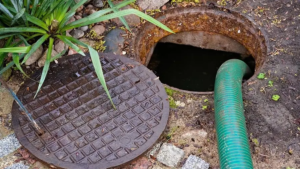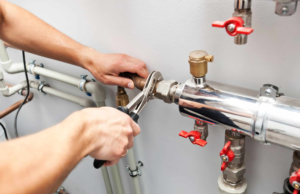Your septic tank is an essential part of your on-site wastewater system. Preventative maintenance can avoid major issues and minimize the cost of cleanup.
Solid wastes settle in the septic tank, forming a layer of sludge. Oil and grease floats to the top as scum. The effluent pipe sends the partially-processed sewage to the soil absorption field or drain field. Contact Septic Tank Services Near Me now!

If you have a septic tank, it’s vital to get it inspected regularly. Ideally, you should have a visual inspection every year or two and a full inspection every three to five years. In addition to checking for sludge and effluent levels, these tests will ensure the waste is being properly disposed of.
A visual septic tank inspection is fairly simple and can be done quickly. The inspector will ask you a few basic questions like how old the house is and when the septic system was last pumped. They will also flush all the toilets in the house and run water from different parts of the home to see if everything is draining as it should. Finally, they will go outside to check the drain field for standing water that could lead to cesspool formation.
To perform a full inspection, the inspector will have to pump out the septic tank to get a better look at it. They will remove the cover and use a flashlight to look for cracked, chipping, rotting spots, or other problems. They will also test the level of scum and sludge by measuring it with a probe. The scum should be no more than 30% of the total tank volume, and the sludge should be no more than 40%.
The inspector will also examine the inlet and outlet baffles to make sure they are in good working condition and connected firmly to the inlet and outlet pipes. The baffles regulate the flow of waste into the septic tank, and they keep solids from reaching the drain field. They can wear out over time, and regular inspections help you decide when to replace them.
The inspector will also check the ground over the drainfield for sogginess or ponding, which may indicate improper drainage, a clogged septic system, or excessive water use. They will also check the septic system for any leaks, and they will use a dye to see if any wastewater is entering the drain field. If they find any, they will recommend a drainfield inspection, which is a separate process.
Septic tanks are used in homes that are not connected to a public sewer system to treat wastewater and separate solid waste from liquids. The liquid portion of waste is disposed of in a drain field where natural filtering occurs in the soil. The solid waste is stored in a septic tank until it is pumped out periodically to remove the heavy materials that can clog drains, sinks and toilets.
The cost of septic tank pumping varies by region and the size of the septic tank. It can also vary between plumbing companies. It is important to find a qualified plumbing company that is licensed and insured. You should also ensure that they offer septic tank cleaning services in addition to septic tank pumping.
Having your septic tank pumped regularly is the best way to prevent a buildup of solid waste that can clog or infiltrate your household plumbing. This is especially true in sandy or limestone soil areas where pathogenic bacteria may move into groundwater and surface water more easily.
When you get your septic tank pumped, the plumber should inspect it for leaks and other issues that could require repair or replacement. You can reduce the frequency of pumping and maintenance visits by limiting what is flushed down the drains and toilets. Paper towels, cigarette butts, coffee grounds, chemical drain cleaner and bleach should not be put down the drain. These substances can cause septic systems to fill faster and create more problems for the homeowner.
A septic tank is buried underground and is made of concrete, fiberglass or polyethylene. Wastewater flows into it and the solids settle at the bottom of the tank where they are broken down by bacteria to form sludge. The sludge and scum are then separated from the liquid wastewater, which is known as effluent, and released into the absorption field.
The absorption field is a series of trenches where the effluent percolates into the soil. This natural treatment process removes harmful bacteria, viruses and nutrients.
The distribution box in a septic tank evenly distributes the wastewater into the different parts of the absorption field. This helps prevent overflows and ensures that the entire field receives proper treatment.
A well-functioning septic tank system separates the wastewater from clean water in your home, so it’s important to have regular service done on the septic tank system to keep it working correctly. A professional technician will check the septic tank and other parts of the septic tank system for signs of damage or problems. A clogged outlet baffle or effluent filter may need to be cleaned out or replaced to prevent sewage from backing up into the house or in the yard.
If a family’s usage has changed significantly, the septic tank should be inspected to ensure that it is large enough to handle the increased load. If the septic tank is not large enough, it will need to be enlarged and a new drain field installed. In some cases, a septic system will need to be replaced completely, especially when it has been improperly cared for or neglected.
Leaking septic tanks are usually the result of a combination of issues, including improper maintenance, environmental factors and design flaws. However, even properly maintained septic systems can fail due to a sudden increase in household use. This can be caused by a change in the number of people living in a home, cleaning products added to the waste or heavy rains that flood the drain field.
The best way to avoid costly septic tank repairs is by having the system professionally inspected and pumped on a regular basis. A professional can also help homeowners avoid problems by encouraging them to minimize the amount of waste they put into the septic system and by installing a septic tank alarm.
When you choose a company to provide septic tank services, look for one with a good reputation and excellent customer service. Make sure that the company is licensed and insured to perform all the services that it offers, and ask for references from previous customers. In addition, you can research the company on the Internet to learn more about its services and how it treats its customers. The employees at a septic tank services company should have the knowledge, skills and motivation to do a great job for their customers.
When installing a septic system, the process involves digging trenches and working with heavy equipment. It also requires careful planning and connections to ensure proper operation of the septic tank, drain field, or alternative waste treatment technology. Professional installers have the tools and expertise to handle all aspects of septic tank installation, reducing the risk of problems down the road.
Improper septic tank placement and size can cause groundwater contamination, soil erosion, and other environmental concerns. In addition, choosing the wrong septic tank size or location can lead to frequent maintenance issues and costly repairs. A septic tank services company can evaluate the property layout, soil composition, and surrounding environmental conditions to determine the best system design for the homeowner’s unique needs.
Regardless of the type of septic system chosen, it is important to have the tank inspected regularly by a licensed septic tank service company. This will help to avoid costly repairs and extend the life of the system. A septic tank inspection can detect problems such as a cracked or damaged tank, clogged baffle, corroded outlet valves, or leaks. The septic tank service company can also check for the presence of harmful bacteria and other potential contaminants in the tank and drain field.
The septic tank is a large underground container that holds all wastewater discharged from household plumbing. Solid wastes, called sludge, settle at the bottom of the tank while oil and fats, known as scum, float to the top. Bacteria in the tank breaks down these materials over time, while liquid wastewater (called effluent) exits the tank through a baffle and into a drain field.
Depending on the type of septic system installed, the absorption field may be comprised of a series of perforated pipes, gravel, or constructed wetlands that slowly release the wastewater into the ground. The water seeps into the soil and is naturally filtered by the microbes present in the groundwater.
If you have a complaint or dispute with your septic tank company, it’s always best to consult a legal professional. They can advise you on the feasibility of taking legal action and provide guidance on the steps to take. In addition, they can help you find local resources that can offer support or advice.
